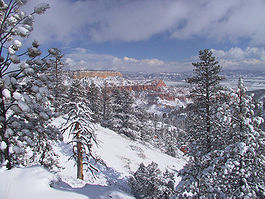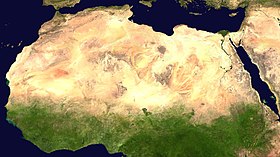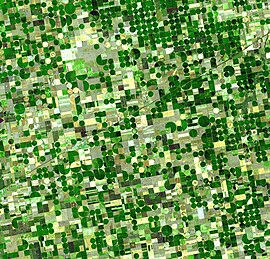Portal:Geography/Featured picture archive/2006
This is the 2006 archive of Geography portal selected pictures.
 |
|
Jökulsárlón, a glacial lake in Iceland. It is situated at the south end of the glacier Vatnajökull between the Skaftafell National Park and Höfn. Appearing first only in 1934-1935, the lake grew from 7.9 km² in 1975 to over 18 km² due to heavy melting of the Icelandic glaciers. Jökulsárlón is now the second deepest lake in Iceland with nearly 200 m in depth. To the right, the mouth of the glacier Vatnajökull can also be seen. Photo credit: Kenny Muir |
 |
|
Cabo da Roca, Portugal, the westernmost point of mainland Europe. Photo credit: Pauldavidgill |
 |
|
The Lena River delta has a size of about 45,000 km². |
 |
|
World map: Kyoto Protocol participation (2005). Image credit: Verdy p |
 |
|
Photo credit: DDD DDD, 2003 |
 |
|
Vegetation map of Peru. Image credit: by Central Intelligence Agency, retrieved from lib.utexas.edu |
 |
|
Photo credit: PDphoto.org |
 |
|
Delicate Arch, located at Arches National Park in Moab, Utah, United States is a natural arch. Photo credit: U.S. National Park Service |
 |
|
Annual mean sea surface salinity (in Practical Salinity Units) plotted here using a Mollweide projection. Image credit: Plumbago |
 |
|
Coastal salt marsh (Bride Brook Salt Marsh) in East Lyme, Connecticut. Photo credit: by Alex756, July 2003 |
 |
|
An arcuate river delta has formed on the south-west coastline of Greenland, near Narsarsuaq. Photo credit: Codrington, Stephen. Planet Geography 3rd Edition (2005) Chapter 8 |
 |
|
Speleothems in Hall of the Mountain Kings, Ogof Craig a Ffynnon, South Wales. Photo credit: Rls. |
 |
|
Photo credit: Fir0002. |
 |
|
Horseshoe Bend, Arizona as seen from the lookout point. Photo credit: Moondigger. |
 |
|
Horseshoe Bend, Arizona as seen from the lookout point. Photo credit: Moondigger. |
 Morning mist on Lake Mapourika, which is located on the West Coast of New Zealand's South Island, about five kilometres north of Franz Josef Glacier.cr Image credit: Richard Palmer. |
 Morning mist on Lake Mapourika, which is located on the West Coast of New Zealand's South Island, about five kilometres north of Franz Josef Glacier.cr Image credit: Richard Palmer. |
|
A barn at the Grand Teton National Park. The United States National Park, named after Grand Teton of the Teton Range, is located in western Wyoming, south of Yellowstone. The park is located in the heart of the Greater Yellowstone Ecosystem, one of the largest intact temperate zone ecosystems remaining on the planet. Photo credit: Jon Sullivan |
 Morning mist on Lake Mapourika, which is located on the West Coast of New Zealand's South Island, about five kilometres north of Franz Josef Glacier. Image credit: Richard Palmer. |
 Morning mist on Lake Mapourika, which is located on the West Coast of New Zealand's South Island, about five kilometres north of Franz Josef Glacier. Image credit: Richard Palmer. |
 Morning mist on Lake Mapourika, which is located on the West Coast of New Zealand's South Island, about five kilometres north of Franz Josef Glacier. Image credit: Richard Palmer. |
 Lipa Noi Beach on Ko Samui, Thailand, shortly after sunset. The islands of the Ang Thong Marine National Park (Mu Koh Angthong) are visible at the horizon. Image credit: Manfred Werner. |
 Lipa Noi Beach on Ko Samui, Thailand, shortly after sunset. The islands of the Ang Thong Marine National Park (Mu Koh Angthong) are visible at the horizon. Image credit: Manfred Werner. |
July 2006
[edit]
Featured geography picture[edit]
|
Featured geography picture[edit]
|
Featured geography picture[edit]
|
June 2006
[edit]June 25 - July 1, 2006
[edit]
Featured geography picture[edit] |
 Cerro de la Silla, a mountain in Monterrey, Mexico. Photo credit: Nathaniel C. Sheetz. |
June 18 - June 24, 2006
[edit]
Featured geography picture[edit] |
 This map shows the world as was known to Han Dynasty China in 2 CE. The shaded areas show the extent of Han civilisation. I've based this on the existence of settlements under direct Han political authority or military control according to Tan Qixiang (ed.), Zhongguo lishi ditu (中国历史地图集; 1982). Map credit: Yeu Ninje. |
June 11 - June 17, 2006
[edit]
Featured geography picture[edit] |
 Winter storm at Bryce Canyon National Park. Photo credit: National Park Service. |
June 4 - June 10, 2006
[edit]
Featured geography picture[edit] |
 Hanko, Finland. Panoramic photo shot from the water tower. Photo credit: J-E Nyström. |
May 2006
[edit]May 28 - June 3, 2006
[edit]
Featured geography picture[edit] |
 Sahara desert seen from satellite. Image credit: NASA's Visible Earth project. |
May 21 - May 27, 2006
[edit]
Featured geography picture[edit] |
 Lauterbrunnen valley during winter, Interlaken (district) of the Bernese Oberland, Switzerland. Photo credit: Keith Halstead (February 2005). |
May 1 - May 20, 2006
[edit]
Featured geography picture[edit] |
 Manila is the capital of the Philippines, and the second most populous city proper in the Philippines, with more than 1.5 million inhabitants. The city is located on the eastern shore of Manila Bay on Luzon, the country's largest island. Map credit: Seav |
April 2006
[edit]
Featured geography picture[edit] |
 A rainforest is a forested biome with high annual rainfall. Tropical rainforests arise due to the Intertropical Convergence Zone, but temperate rainforests also exist. As well as prodigious rainfall, many rainforests are characterized by a high number of resident species and tremendous biodiversity. Botanical gardens grow a wide variety of plants primarily categorized and documented for scientific purposes, but also for the enjoyment and education of visitors, a consideration that has become essential to secure public funding. Photo credit: Fir0002 |
March 26, 2006
[edit]
Featured geography picture[edit] |
 Machu Picchu is a well-preserved pre-Columbian Inca ruin located on a high mountain ridge, at an elevation of about 2,350 m (7,710 ft). Machu Picchu is located above the Urubamba Valley in Peru, about 70 km (44 mi) northwest of Cusco. Geographic coordinates: 13°09′47″S 72°32′44″W / 13.16306°S 72.54556°W. |
February 16, 2006
[edit]
Featured geography picture[edit] |
 Mount Cook, a peak in the Southern Alps is the highest mountain in New Zealand. Mount Cook is also known as Aoraki, meaning "Cloud Piercer" in the Kai Tahu dialect of the Maori language. The mountain is located within the Aoraki/Mount Cook National Park and was formally declared one of the United Nations World Heritage Parks in 1953. |



